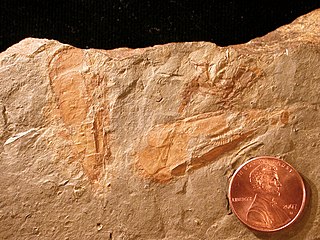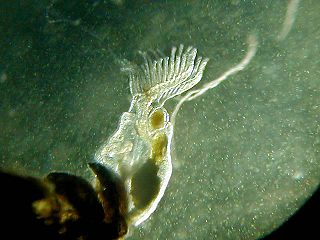
Agnostida is an order of arthropod which first developed near the end of the Early Cambrian period and thrived during the Middle Cambrian. They are present in the Lower Cambrian fossil record along with trilobites from the Redlichiida, Corynexochida, and Ptychopariida orders. The last agnostids went extinct in the Late Ordovician.

Hyoliths are animals with small conical shells, known as fossils from the Palaeozoic Era. They are lophophorates, a group which includes the brachiopods.

The lophophore is a characteristic feeding organ possessed by four major groups of animals: the Brachiopoda, Bryozoa, Hyolitha, and Phoronida, which collectively constitute the protostome group Lophophorata. All lophophores are found in aquatic organisms.

Haplophrentis is a genus of tiny shelled hyolithid which lived in the Cambrian Period. Its shell was long and conical, with the open end protected by an operculum, from which two fleshy arms called helens protruded at the sides. These arms served to elevate the opening of the shells above the sea floor, acting like stilts.
Cambrorhytium is an enigmatic fossil genus known from the Latham Shale (California), and the Chengjiang (China) and Burgess Shale lagerstätte. 350 specimens of Cambrorhytium are known from the Greater Phyllopod bed, where they comprise 0.7% of the community.
Stenothecoida is a taxon of bivalved fossils from the Early to middle Cambrian period. They look a bit like brachiopods or bivalve molluscs.
Turcutheca is a Tommotian genus of shelly fossil whose affinities are uncertain, generally considered as an orthothecid hyolith (which would make it a brachiopod, but also resembling the ellesmeroceratids.
Mobergella is a millimetric Lower Cambrian shelly fossil of unknown affinity, usually preserved in phosphate and particularly well known from Swedish strata, where it is diagnostic of lowermost Cambrian rocks. Originally interpreted as a monoplacophoran, the circular, cap-shaped shell resembles a hyolith operculum, with concentric rings on its upper surface, and seven pairs of internal muscle scars. It is never found in association with a conch, and its affinity therefore remains undetermined. Nevertheless, its heavy musculature does seem to indicate that it functioned as an operculum.
Orthotheca is a genus of sessile bottom-dwelling hyolith.
Ladatheca is a genus of hyolith that closely resembles Turcutheca. It has a straight conch with a smooth internal surface, and is found with what may be its operculum.
The orthothecids are one of the two hyolith orders.
The Hyolithida are lophophorates, one of the two orders of hyolithid, the other being the Orthothecida. Most of our knowledge of the hyolithids comes from studies on the Hyolithida. Both orders had an operculum that was not hinged to the conch. However, the Hyolithida are distinct from the Orthothecida in lacking additional paired, curved, whiskerlike appendages. The Hyolithida were probably bottom feeders living in shallow water, and had tentacules.
Hyolithellus is a conical tubular fossil from the Cambrian, originally considered a hyolith but since reinterpreted tentatively as an annelid worm.
Angarella is an early palaeozoic genus of problematic fossils, long held to belong to the molluscs based on supposed similarities in its musculature to that of hyoliths and mobergellids, but now considered to represent a brachiopod based on its calcitic mineralogy and paired symmetrical valves.
Slapylitidae is a family of hyolithid hyoliths known from articulated skeletons lacking helens. The two included genera, Slapylites and Nevadalites , are found in the mid-Cambrian, particularly of the Barrundian area; a possible additional representative in the open systematic nomenclature may extend the range of the genus to the Devonian.
Cupitheca is a genus of Cambrian hyolith with the unusual distinction of shedding the apex of its camerate conical shell. As with Triplicatella and Hyptiotheca, its designation to the hyolithids or orthrothecids is not straightforward, exhibiting as it does a mixture of the characters that would normally demark the two subtaxa of Hyolitha.
Conotheca is a genus of Cambrian hyoliths.
Pedunculotheca is a genus of orthothecid hyolith known from the Chengjiang biota of China, notable for its possession of a pedunculate attachment structure likened to the brachiopod pedicle.
Hyolithohelminths are phosphatic tubular fossils from the Cambrian period. They were sedentary, possibly infanual, organisms; once thought to have opercular, these structures are now understood to be unrelated shells.



